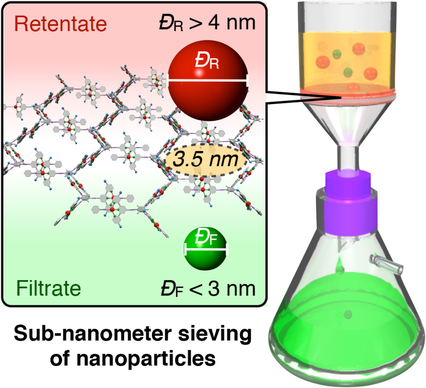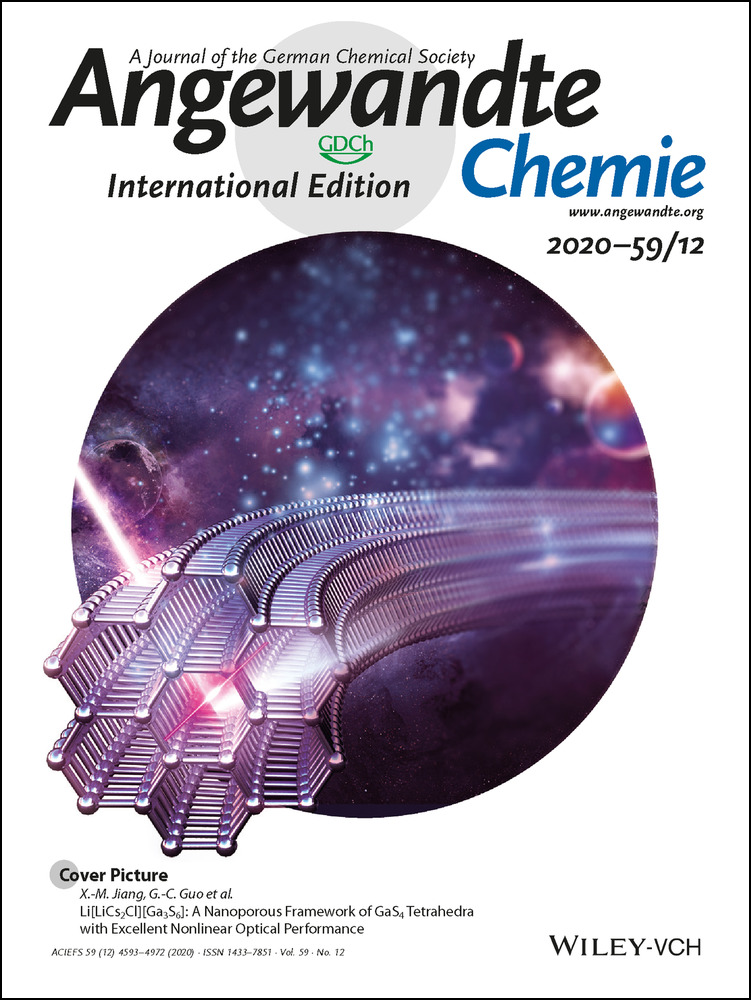Precise Size-Selective Sieving of Nanoparticles Using a Highly Oriented Two-Dimensional Supramolecular Polymer
Dr. Zhen Chen
Institute of Molecular Functional Materials and Department of Chemistry, The University of Hong Kong, Pokfulam Road, Hong Kong, P. R. China
Search for more papers by this authorCorresponding Author
Prof. Dr. Vivian Wing-Wah Yam
Institute of Molecular Functional Materials and Department of Chemistry, The University of Hong Kong, Pokfulam Road, Hong Kong, P. R. China
Search for more papers by this authorDr. Zhen Chen
Institute of Molecular Functional Materials and Department of Chemistry, The University of Hong Kong, Pokfulam Road, Hong Kong, P. R. China
Search for more papers by this authorCorresponding Author
Prof. Dr. Vivian Wing-Wah Yam
Institute of Molecular Functional Materials and Department of Chemistry, The University of Hong Kong, Pokfulam Road, Hong Kong, P. R. China
Search for more papers by this authorGraphical Abstract
Sub-nm sieving: A flexible supramolecular membrane for the sub-nanometer sieving of nanoparticles is developed. This membrane comprises a highly oriented, honeycomb-like, two-dimensional supramolecular polymer with uniform nanocavities. Owing to this unique structural feature, a precise cutoff size of about 4 nm has been realized.
Abstract
The development of size-selective membranes with well-defined nanopores towards the precise separation of nanometer-sized substances is a challenging task to achieve. Here a supramolecular membrane is presented that comprises a highly oriented, honeycomb-like, 2D supramolecular polymer on a polycarbonate filter support. It enables precise size-selective sieving of colloidal nanoparticles (NPs). Owing to the uniform parallel-aligned nanocavities within the 2D supramolecular polymers, the composite membrane shows a high size-selectivity with a sub-nanometer accuracy in the cutoff size of about 4.0 nm. In principle, the species of size-separable particles are unlimited, as demonstrated by quantum dots, noble metal, and metal oxide NPs. This supramolecular membrane combined with filtration advances the potential of NPs in terms of their monochromatic emission and size monodispersity, and also enables rapid removal of small magnetic NP adsorbents that are otherwise difficult to capture.
Supporting Information
As a service to our authors and readers, this journal provides supporting information supplied by the authors. Such materials are peer reviewed and may be re-organized for online delivery, but are not copy-edited or typeset. Technical support issues arising from supporting information (other than missing files) should be addressed to the authors.
| Filename | Description |
|---|---|
| anie201913621-sup-0001-misc_information.pdf5.6 MB | Supplementary |
| anie201913621-sup-0001-Video_S1.mp421.5 MB | Supplementary |
| anie201913621-sup-0001-Video_S2.mp413.9 MB | Supplementary |
Please note: The publisher is not responsible for the content or functionality of any supporting information supplied by the authors. Any queries (other than missing content) should be directed to the corresponding author for the article.
References
- 1
- 1aH. Mistry, A. S. Varela, S. Kühl, P. Strasser, B. R. Cuenya, Nat. Rev. Mater. 2016, 1, 16009;
- 1bS. Wilhelm, A. J. Tavares, Q. Dai, S. Ohta, J. Audet, H. F. Dvorak, W. C. W. Chan, Nat. Rev. Mater. 2016, 1, 16014;
- 1cP. Xu, G. Zeng, D. Huang, C. Feng, S. Hu, M. Zhao, C. Lai, Z. Wei, C. Huang, G. Xie, Z. Liu, Sci. Total Environ. 2012, 424, 1–10;
- 1dY.-K. Peng, S. C. E. Tsang, P.-T. Chou, Mater. Today 2016, 19, 336–348.
- 2F. Peng, M. I. Setyawati, J. K. Lee, X. Ding, J. Wang, M. E. Nga, H. K. Ho, D. T. Leong, Nat. Nanotechnol. 2019, 14, 279–286.
- 3
- 3aJ. Gopal, N. Hasan, M. Manikandan, H. Wu, Sci. Rep. 2013, 3, 1260;
- 3bY. Yamagishi, A. Watari, Y. Hayada, X. Li, M. Kondoh, Y. Tsutsumi, K. Yagi, Pharmazie 2013, 68, 178–182;
- 3cY. Yamagishi, A. Watari, Y. Hayada, X. Li, M. Kondoh, Y. Yoshioka, Y. Tsutsumi, K. Yagi, Nanoscale Res. Lett. 2013, 8, 395.
- 4
- 4aL. Bai, X. Ma, J. Liu, X. Sun, D. Zhao, D. G. Evans, J. Am. Chem. Soc. 2010, 132, 2333–2337;
- 4bA. Chemseddine, H. Weller, Ber. Bunsen-Ges. 1993, 97, 636–637;
- 4cM. Hanauer, S. Pierrat, I. Zins, A. Lotz, C. Sönnichsen, Nano Lett. 2007, 7, 2881–2885;
- 4dJ. R. Stephens, J. S. Beveridge, M. E. Williams, Phys. Chem. Chem. Phys. 2012, 14, 3280–3289;
- 4eC. T. Yavuz, J. T. Mayo, W. W. Yu, A. Prakash, J. C. Falkner, S. Yean, L. Cong, H. J. Shipley, A. Kan, M. Tomson, D. Natelson, V. L. Colvin, Science 2006, 314, 964–967.
- 5
- 5aA. Akthakul, A. I. Hochbaum, F. Stellacci, A. M. Mayes, Adv. Mater. 2005, 17, 532–535;
- 5bT. R. Gaborski, J. L. Snyder, C. C. Striemer, D. Z. Fang, M. Hoffman, P. M. Fauchet, J. L. McGrath, ACS Nano 2010, 4, 6973–6981;
- 5cK. Dey, S. H. Kunjattu, A. M. Chahande, R. Banerjee, Angew. Chem. Int. Ed. 2020, 59, 1161–1165; Angew. Chem. 2020, 132, 1177–1181.
- 6
- 6aP. J. J. Alvarez, C. K. Chan, M. Elimelech, N. J. Halas, D. Villagrán, Nat. Nanotechnol. 2018, 13, 634–641;
- 6bB. C. Hodges, E. L. Cates, J.-H. Kim, Nat. Nanotechnol. 2018, 13, 642–650.
- 7
- 7aM. E. Davis, Nature 2002, 417, 813–821;
- 7bL. Wang, M. S. H. Boutilier, P. R. Kidambi, D. Jang, N. G. Hadjiconstantinou, R. Karnik, Nat. Nanotechnol. 2017, 12, 509–522;
- 7cP. Marchetti, M. F. J. Solomon, G. Szekely, A. G. Livingston, Chem. Rev. 2014, 114, 10735–10806;
- 7dJ. R. Werber, C. O. Osuji, M. Elimelech, Nat. Rev. Mater. 2016, 1, 16018.
- 8
- 8aY. Ying, Y. Yang, W. Ying, X. Peng, Nanotechnology 2016, 27, 332001;
- 8bK. Celebi, J. Buchheim, R. M. Wyss, A. Droudian, P. Gasser, I. Shorubalko, J. Kye, C. Lee, H. G. Park, Science 2014, 344, 289–292;
- 8cJ. Abraham, K. S. Vasu, C. D. Williams, K. Gopinadhan, Y. Su, C. T. Cherian, J. Dix, E. Prestat, S. J. Haigh, I. V. Grigorieva, P. Carbone, A. K. Geim, R. R. Nair, Nat. Nanotechnol. 2017, 12, 546–550;
- 8dK. Gopinadhan, S. Hu, A. Esfandiar, M. Lozada-Hidalgo, F. C. Wang, Q. Yang, A. V. Tyurnina, A. Keerthi, B. Radha, A. K. Geim, Science 2019, 363, 145–148;
- 8eS. Kim, H. Wang, Y. M. Lee, Angew. Chem. Int. Ed. 2019, 58, 17512–17527; Angew. Chem. 2019, 131, 17674–17689.
- 9
- 9aJ. W. Colson, W. R. Dichtel, Nat. Chem. 2013, 5, 453–465;
- 9bS. C. Diercks, O. M. Yaghi, Science 2017, 355, eaal 1585.
- 10
- 10aJ. W. Colson, A. R. Woll, A. Mukherjee, M. P. Levendorf, E. L. Spitler, V. B. Shields, M. G. Spencer, J. Park, W. R. Dichtel, Science 2011, 332, 228–230;
- 10bS. Kandambeth, B. P. Biswal, H. D. Chaudhari, K. C. Rout, S. K. H. S. Mitra, S. Karak, A. Das, R. Mukherjee, U. K. Kharul, R. Banerjee, Adv. Mater. 2017, 29, 1603945;
- 10cY. Zhao, L. Guo, F. Gándara, Y. Ma, Z. Liu, C. Zhu, H. Lyu, C. A. Trickett, E. A. Kapustin, O. Terasaki, O. M. Yaghi, J. Am. Chem. Soc. 2017, 139, 13166–13172;
- 10dK. Dey, M. Pal, K. C. Rout, H. S. Kunjattu, A. Das, R. Mukherjee, U. K. Kharul, R. Banerjee, J. Am. Chem. Soc. 2017, 139, 13083–13091;
- 10eM. Matsumoto, L. Valentino, G. M. Stiehl, H. B. Balch, A. R. Corcos, F. Wang, D. C. Ralph, B. J. Mariñas, W. R. Dichtel, Chem 2018, 4, 308–317;
- 10fA. M. Evans, L. R. Parent, N. C. Flanders, R. P. Bisbey, E. Vitaku, M. S. Kirschner, R. D. Schaller, L. X. Chen, N. C. Gianneschi, W. R. Dichtel, Science 2018, 361, 52–57.
- 11
- 11aE. Weissman, E. Shirman, E. Shimoni, B. Rybtchinski, Nat. Nanotechnol. 2011, 6, 141–146;
- 11bE. Cohen, H. Weissman, E. Shimoni, I. K. Ashiri, K. Werle, W. Wohlleben, B. Rybtchinski, Angew. Chem. Int. Ed. 2017, 56, 2203–2207; Angew. Chem. 2017, 129, 2237–2242.
- 12
- 12aK. Zhang, J. Tian, D. Hanifi, Y. Zhang, A. C. Sue, T. Zhou, L. Zhang, X. Zhao, Y. Liu, Z. Li, J. Am. Chem. Soc. 2013, 135, 17913–17918;
- 12bR. Sakamoto, K. Hoshiko, Q. Liu, T. Yagi, T. Nagayama, S. Kusaka, M. Tsuchiya, Y. Kitagawa, W.-Y. Wong, H. Nishihara, Nat. Commun. 2015, 6, 6713;
- 12cL. Yue, S. Wang, D. Zhou, H. Zhang, L. Wu, Nat. Commun. 2016, 7, 10742;
- 12dS. Zhang, J. Zhang, W. Fang, Y. Zhang, Q. Wang, J. Jin, Nano Lett. 2018, 18, 6563–6569.
- 13
- 13aZ. Chen, A. K.-W. Chan, V. C.-H. Wong, V. W.-W. Yam, J. Am. Chem. Soc. 2019, 141, 11204–11211;
- 13bV. W.-W. Yam, V. K.-M. Au, S. Y.-L. Leung, Chem. Rev. 2015, 115, 7589–7728;
- 13cA. K.-W. Chan, V. W.-W. Yam, Acc. Chem. Res. 2018, 51, 3041–3051;
- 13dF. K.-W. Kong, A. K.-W. Chan, M. Ng, K.-H. Low, V. W.-W. Yam, Angew. Chem. Int. Ed. 2017, 56, 15103–15107; Angew. Chem. 2017, 129, 15299–15303.
- 14
- 14aP. Alivisatos, Nat. Biotechnol. 2004, 22, 47–52;
- 14bP. Senellart, G. Solomon, A. White, Nat. Nanotechnol. 2017, 12, 1026–1039.
- 15N. Gaponik, D. V. Talapin, A. L. Rogach, K. Hoppe, E. V. Schevchenko, A. Kornowski, A. Eychmüller, H. Weller, J. Phys. Chem. B 2002, 106, 7177–7185.
- 16
- 16aW. Yu, M. D. Porosoff, J. G. Chen, Chem. Rev. 2012, 112, 5780–5817;
- 16bG. A. Somorjai, A. M. Contreras, M. Montano, R. M. Rioux, Proc. Natl. Acad. Sci. USA 2006, 103, 10577–10583.
- 17
- 17aY. Yu, B. Xu, Appl. Organomet. Chem. 2006, 20, 638–647;
- 17bS. Chen, Q. Yang, H. Wang, S. Zhang, J. Li, Y. Wang, W. Chu, Q. Ye, L. Song, Nano Lett. 2015, 15, 5961–5968.
- 18
- 18aN. N. Nassar, J. Hazard. Mater. 2010, 184, 538–546;
- 18bN. Wang, D. Yang, X. Wang, S. Yu, H. Wang, T. Wen, G. Song, Z. Yu, X. Wang, Inorg. Chem. Front. 2018, 5, 2174–2182.
- 19
- 19aQ. Zhao, N. Chen, D. Zhao, X. Lu, ACS Appl. Mater. Interfaces 2013, 5, 11453–11461;
- 19bY. Liu, T. Chen, C. Wu, L. Qiu, R. Hu, J. Li, S. Cansiz, L. Zhang, C. Cui, G. Zhu, M. You, T. Zhang, W. Tan, J. Am. Chem. Soc. 2014, 136, 12552–12555.





